The Mackenzie-class destroyer was four Royal Canadian Navy and Canadian Forces destroyers escort built in 1958-63 and in service until the end of the cold war in 1992-94. Six were planned initially but the last two were eventually to completed as DDH conversion St. Laurent-class design with helicopter hangars and became Annapolis class ships instead. The four Mackenzie-class destroyers were named after West Canadian provinces and they served in the Pacific, mostly for ASW training. Their major DELEX (destroyer life extension) program upgrade in 1982 and 1985 enabled them to stay active for another decade thanks to upgrades to their navigational radar and sonar. They were still however in design and philosophy very close to the St. Laurent and Restigouche class of the 1950s. For all their career their wartime target remained Soviet submarines of the Pacific fleet. #RCAN #canada #canadiannavy #canadianforces #mackenzie #saskatchewan #yukon #destroyer #coldwar
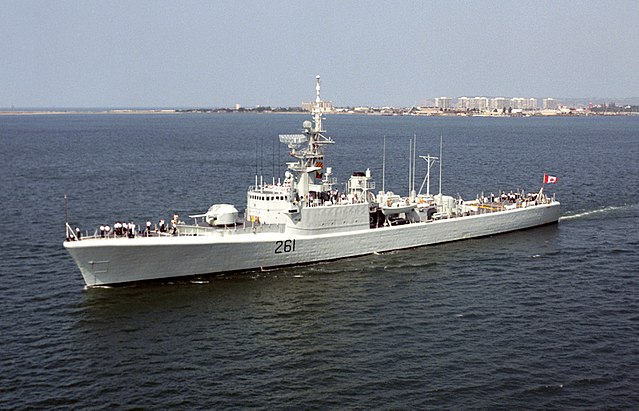
Design of the class
The Mackenzie class were based on the preceding Restigouche and themselves closely derived from St. Laurent-class which developmental process and thoughts went back to the role played by Canada in ASW warfare in the north Atlantic (mainly) with a naval force tha became the world’s 4th in 1945. Withing the context of deeper diving, faster Whiskey class from the Soviet Unions (NATO estimated a hundred would be available in case of war at once in the Atlantic North) it was proposed to creat a very robust escort design tailored only for ASW operations, fast but mostly rugged enough to stay active in the worst weather conditions, icy and damp. The hull was created like a battering ram to ride ot cut through the largest wave and prevent water ingress. There was internal heating as well and de-humidifiers to lake the crew’s life easier. They were large ships in size and tonnage, but yet looked underarmed.
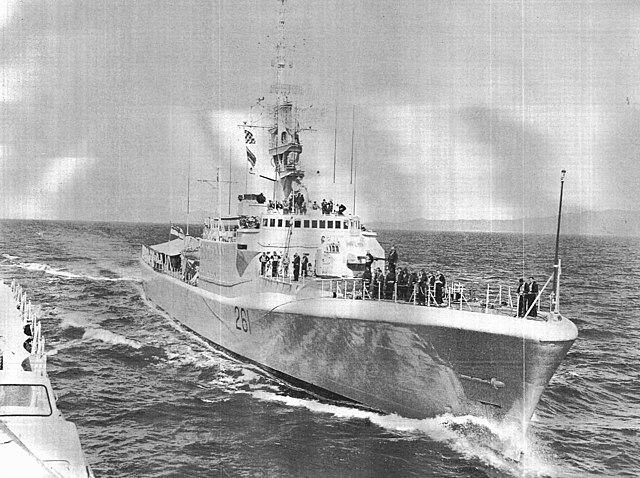
The St. laurent were needed fast, and their design was not as refined as it could but they had an helicopter later in their career operating the Westland Sea King and the next batch of seven Restigouche class shared the same hull with a weaponry was completely redesigned over a 2,000 tonnes (2,000 long tons) standard displacement, 2,500 t deep load over 112 metres (366 ft) long, 13 metres (42 ft) wide, crew of 214. They were class as ASW escorts (DDE) but for the next class, the admiralt wanted to improve further on the design and initially for the Mackenzie class destined for the pacific, it was decided for extra range and thus, for an enlarged version of the St. Laurent class.
The Mackenzie design started in 1957, and this was a radical increase in size and displacement, which was to be 1,000 tonnes (980 long tons) heavier, 50 feet (15 m) longer with new engines capable of producing 20,000 horsepower (15,000 kW) more than previous classes. They were also designed to receive an improved radar and a better sonar installed, but instead, budget issues forced this down to a repeat of the previous Restigouche class, with limited changes instead. Four ships were ordered in 1957, two more in 1958 at an individual cost which gradually rose to $28 million.
In 1959, their design of the last two (after four completed already) was altered to incorporate changes made in the St. Laurent class and became a separate class known as the Annapolis class. The Maclkenzie had improved habitability and better pre-wetting as well as bridge and weatherdeck fitted with hot water hoses and salt, to better deal with extreme cold.
Hull and general design
No plans but that nice image at warmuseum.ca.
In the end they measured about the same as before at 366 feet (112 m) in length, 42 feet (13 m) in beam and 13 feet 6 inches (4.11 m) in draught for a displacement of 2,380 tonnes (2,380 t) fully loaded and crew of 290. The general outlook was the same as before with a caracteristic stepped hull of half-forecastle, high aft freeboard, which was rounded to the weather deck for better water circulation, expecially forward, very caracteristic of Canadian vessels of the time. The clipper bow was completed by a straight stem and chin below, without sonar bulge. The latter was located in two retractable fins under the keel. The hull had two counter keels aft.
There were two rudders aft, the two shafts were suspended by V type struts. The superstructure was low to preserve stability, with a classic large structure carrying the bridge forward, three-faced, continued by the support for the fore main twin gun mount, protected further by two breakwaters. The forward structure also supported the main mast, cylindrical, supporting four staggered platforms carrying various radars and ending with a lattice. The single funnel was located aft of it, encased in the rear structure without break between.
Aft of it was plenty of deck pace for a rear AA twin mount and the Limbo Mortar as well as Y guns. This aft part, about 1/3 of the lenght saw the concentration of the ASW armament. The hull ended with a transom stern with reverted slope. Given the strnght of the elements in the north atlantic, there was no porthil, apart four in the main bridge structure. Electric lighting and heating all along. The Mackenzie were recoignised as the best of this initial serie of 1950-designed escorts, before the revolution brought by the next Annapolis class. As it was, the design exhausted its usefulness and counting the St laurent class, would be built between
Powerplant
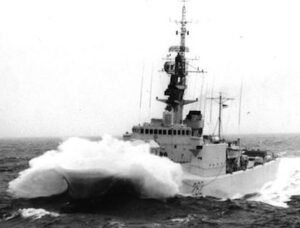 The class was not changung luch compared to the former ones, with twi shafts, driven by two English-Electric geared steam turbines, in turn powered by two Babcock & Wilcox boilers for a total of 30,000 shaft horsepower (22,000 kW) and top speed of 28 knots (52 km/h; 32 mph). It was sufficient for 1st generation conventional Soviet submarines, but no longer for modern SSNs such as the 30 knots November class. At least until helicopters were installed, but not on this class.
The class was not changung luch compared to the former ones, with twi shafts, driven by two English-Electric geared steam turbines, in turn powered by two Babcock & Wilcox boilers for a total of 30,000 shaft horsepower (22,000 kW) and top speed of 28 knots (52 km/h; 32 mph). It was sufficient for 1st generation conventional Soviet submarines, but no longer for modern SSNs such as the 30 knots November class. At least until helicopters were installed, but not on this class.
Armament
The most noticeable change was the replacement of the forward 3-inch (76 mm)/50 Mk 22 guns for the dual Vickers 3-inch/70 calibre Mk 6 mount, more modern and completion with a new type of fire-control director atop the bridge superstructure. The latter also was raised one full deck higher to see above this new gun mount. Qu’Appelle however was fitted by default with the 3-inch/50 instead as the new system was in short supply.
3-in/70 Mark 6 Vickers
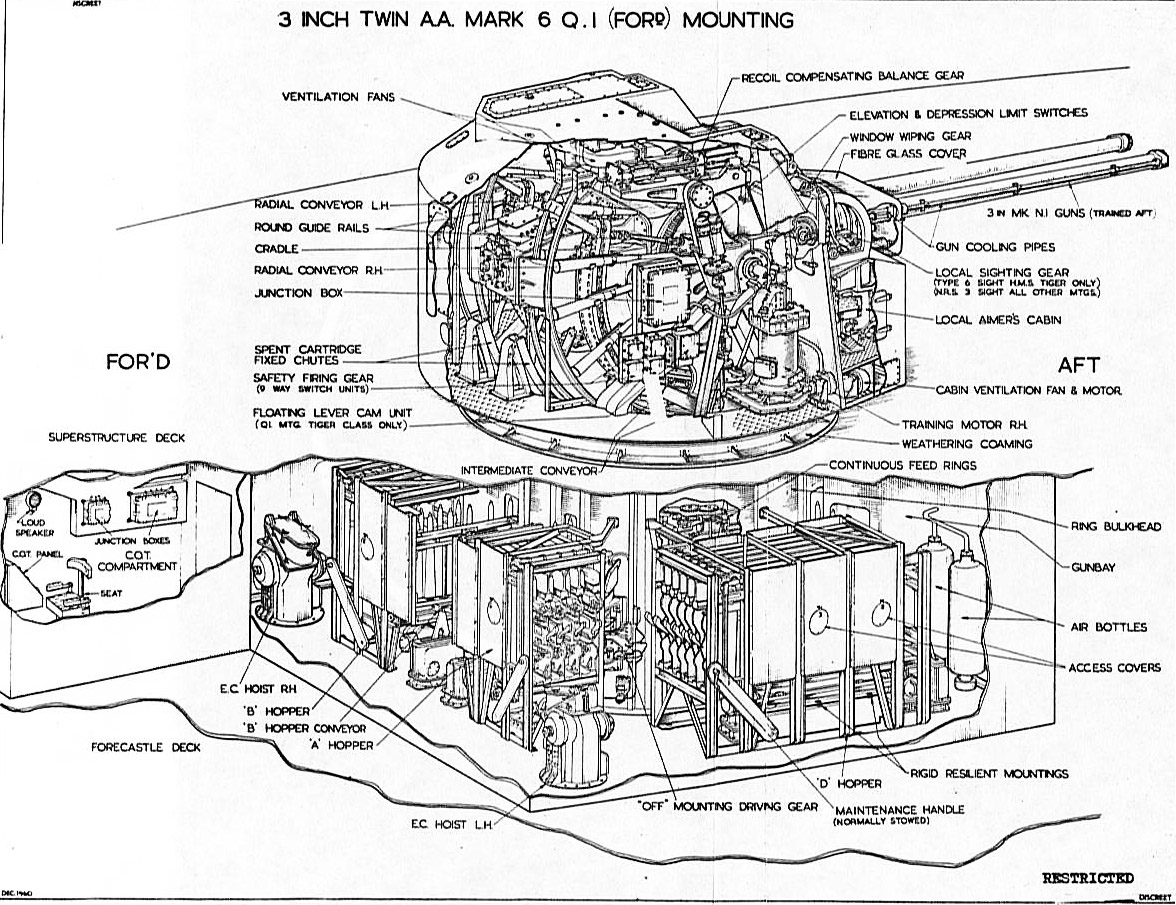
The 3 in/70 Mk 6 gun was initially designed by Vickers for the Tiger-class cruisers and they were only used on the Restigouche and Mackenzie classes, placed in the “A” position. They were far more efficient than the US 3-in Mark.33. But this forward twin mount was beefier. Each gun weighed alone 1,200 kilograms (2,650 lb) with some 1,000 rounds in reserve. Rate of fire was 90 rounds per minute. Each shell weighted 16.4 kilograms (36 lb) and existed the barrel at muzzle velocity of 1,000 metres per second (3,400 ft/s). For memory 70 caliber was the same as the slender 20 mm Oerlikon. It was however 16.9 kilometres (10.5 mi) at 45° degrees with some accuracy.
⚙ specifications 3″/70 Mk.6 Vickers twin mount forward |
|
| Weight | 2,650 lbs. (1,202 kg) per barrel, 83,150 lbs. (37 tons) total with 68 ready rounds |
| Barrel lenght | 210 in (5.334 m) |
| Elevation/Traverse | −15° and 90° (30/s), 360° (60°/s) |
| Loading system | Semi-Auto, chain hoists, non-rotating structure 25 rpm, any angle |
| Muzzle velocity | 1,000 fps |
| Range | 38,000 feet (11,580 m) |
| Guidance | Radar |
| Crew | 12 |
| Round | 16.4 kilograms (36 lb) HE, fuse |
| Rate of Fire | 90 rpm |
3 in (76 mm) Mk.22 on Mk.33 FMC twin mount
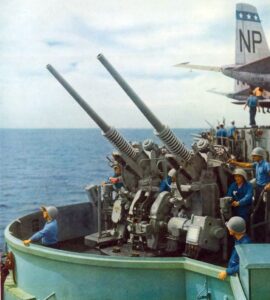 The 3 in/50 Mk 22 dual-purpose gun was a 1942 developed caliber for destroyer escorts. They were installed aft. Each gun weighed 800 kilograms (1,760 lb) and they fired a 10.9 kilograms (24 lb) shell at 820 metres per second (2,700 ft/s). Their Mk 33 twin mount capable of 360° and 85° elevation was semi-open and placed in the ‘Y’ position aft of the ship. Each had a rate of 50 rounds per minute with a useful range of 13 kilometres (8 mi). They were removed for an ASROC after modernization.
The 3 in/50 Mk 22 dual-purpose gun was a 1942 developed caliber for destroyer escorts. They were installed aft. Each gun weighed 800 kilograms (1,760 lb) and they fired a 10.9 kilograms (24 lb) shell at 820 metres per second (2,700 ft/s). Their Mk 33 twin mount capable of 360° and 85° elevation was semi-open and placed in the ‘Y’ position aft of the ship. Each had a rate of 50 rounds per minute with a useful range of 13 kilometres (8 mi). They were removed for an ASROC after modernization.
⚙ specifications 3-in Mk.33 FMC |
|
| Weight | 800 kilograms (1,760 lb) |
| Elevation/Traverse | -10° – +85° and 360° |
| Muzzle velocity | 820 mps |
| Range | 13 kilometres (8 mi) |
| Guidance | Optical, FCS radar data |
| Crew | 2 |
| Round | 10.9 kilograms (24 lb) HE, prox. fuse |
| Rate of Fire | 50 rpm |
Mk NC 10 Limbo ASW mortars
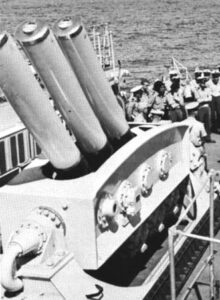 Like the previous class they had a Limbo triple ASW mortar installed in a recess aft of the hull. The Limbo was a British-designed three-barrel mortar capable of launching a projectile shell between 370–910 metres (400–1,000 yd). These used stabilized mountings, to always enter the water at the same angle. Total weight for each was 180 kilograms (390 lb).
Like the previous class they had a Limbo triple ASW mortar installed in a recess aft of the hull. The Limbo was a British-designed three-barrel mortar capable of launching a projectile shell between 370–910 metres (400–1,000 yd). These used stabilized mountings, to always enter the water at the same angle. Total weight for each was 180 kilograms (390 lb).
⚙ specifications Limbo |
|
| Dimensions | 12 inches (30 cm) |
| Range/speed setting | 400 yards (366 m) to 1,000 yards (914 m) |
| Payload | 400 lb depth charge |
| Warhead | 94 kilograms (207 lb) Minol, Proximity/timer |
| Guidance | Direct target data from Type 170 sonar |
Mk.2 “K-gun”
The Mk.2 “K-gun” launchers came out with homing torpedoes. The destroyers were also equipped from 1958 on either beam, midship-aft by Mk 43 homing torpedoes to increase target reach. These US designed Mk 43 torpedo had a range of 4,100 metres (4,500 yd) at 15 knots (28 km/h; 17 mph). They were launched by moduified depth charge thrower but were replaced after modernization by two triple torpedo tubes, less violent that the Y guns, albeit of lesser reach. Improved torpedoes were considered.
⚙ specifications Mk.43 TORPEDO |
|
| Weight | 265 pounds (Mod 3) |
| Dimensions | 91.5 inches x 10 inches |
| Propulsion | Electric |
| Range/speed setting | 4,500 yards at 21 knots (Mod 3) |
| Warhead | 54 pounds Mk 100, HBX, Mk 19 Mod 13 contact exploder |
| Max depth | |
| Guidance | Helix, 6-minute search duration |
103 mm Bofors illumination rocket launchers
These were similar to the ones fitted on Swedish ships, three rails installed on each turret. In the Canadian case, it’s not clear where they were placed. They were used of course to flare out any submarine at night, or any target at large, but better radars made these redundant and these were eliminated later.
Sensors
The Mackenzies had the following suite:
SPS-12 air search radar: L-band, medium surveillance radar for aircraft and surface vessels, first AN/SPS-12 delivered in September 1953. Antenna: Truncated parabolic mesh fed by a massive feed horn, unstabilized vane. Signals shown on a PPI scope and A-scope for range. FRQ 1250 to 1350 MHz PRF 300/600 Hz pwt 4 µs/1 µs, PP 500 kW Range 200 nm (370 km), bwt 3°, 2.5 to 15 rpm.
SPS-10B surface search radar: Raytheon 1959 2D, C Band radar with a PRF of 650 Hz, bwt 1.9° × 16°, pwt 1.3 µs PP 280 kW
Sperry Mk.2 navigation radar: X-band medium range surface search, single curved parabolic reflector, vertical bwt 17°, on all RCN ships between 1950 and 1970, replaced by the Sperry Mk 127E. FRQ 9330 to 9420 MHz, PRF 2 kHz, pwt 0.25 µs, PP 30 kW Range 30 nm (55 km) accuracy 75 m, bwt 2°, 15 rpm
SQS-501 high frequency bottom profiler sonar
SQS-503 hull mounted active search sonar
SQS-502 high frequency mortar control sonar
SQS-11 hull mounted active search sonar
For all, see the whole suite on on hazegray.org/
Active Protection
It was fairly limited, to these three elements:
-DAU (replaced by SRD 501) high frequency direction finder
-WLR 1C radar analyzer
-UPD 501 radar detector
There were no decoys of any sorts or jammers. They would have been rinced by any Soviet SSGN.
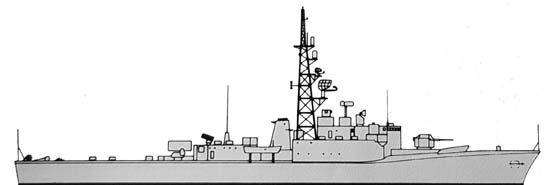
⚙ specifications |
|
| Displacement | 2,800 t (2,380 long tons) deep load |
| Dimensions | 371/366ft x 42 x 14ft (113.1/111.6 x 12.8 x 4.3 m) |
| Propulsion | 2 shafts English-Electric geared steam turbines, 2× Babcock & Wilcox boilers 30,000 shp (22,000 kW) |
| Speed | 28 knots (52 km/h) |
| Range | 4,750 nautical miles (8,800 km) at 14 knots (26 km/h) |
| Armament | 3-in/70 Mk.6, 3-in/50 Mk.33 FMC, 2×Mk NC 10 Limbo, 2× Mk.2 “K-gun”, 103 mm Bofors illum. RL |
| Sensors | SPS-12, SPS-10B, Sperry Mk.2, SQS-501, SQS-502, SQS-503, SQS-11, Mk.69 FCS, GUNAR Mk.64 GFCS |
| Active Protection | DAU HF/DF (high frequency direction finder) |
| Crew | 249 |
Destroyer Life Extension (DELEX)
The DEstroyer Life EXtension (DELEX) refit was planned to give the another decade of useful service and counter obsolescence in the 1980s, until the next generation was built to replace them. All classes from the St. Laurent and Restigouche went through these as well as the latter Annapolis-class. These upgrades aimed at improving their capabilitoes against moern Soviet submarines of the Victor III, Sierra and Alfa class, and having the latest standard for communication and cooperation within a NATO task force. These refits were performed at Esquimalt in British Columbia. The Mackenzie received the exact same upgrade as the improved Restigouche-class:
-New tactical data system ADLIPS
-New radars, modiifications of the SPS-12 air search radar
-New fire control
-Satellite navigation.
-New sonars: SQS-505 installed on the hull
This also concerned armament:
-Two triple mounts 12.75-inch (324 mm) torpedo tubes located on the quarterdeck, replacing the now obsolete Limbo mortars. They launched the Mk 46 homing torpedo capable of 12,000 yards (11,000 m) at 40+ knots with 96.8 pounds (43.9 kg) HE warghead.
 HMCS Mackenzie DDE 261 (1961)
HMCS Mackenzie DDE 261 (1961)

HMCS Mackenzie, pennant 261 was laid down at Canadian Vickers, Montreal in Quebec on 15 December 1958. She was launched on 25 May 1961 and completed on 6 October 1962. Modernized in 1985 and decom. on 3 August 1993, sold on March 1995 to an Artificial Reef Society of British Columbia. She was scuttled off Sidney, British Columbia on 16 September 1995.
Her career started after commission on 6 October 1962 as DDE 261, assigned at first to the Atlantic Fleet, Halifax, until transferred to the Pacific on 2 March 1963. She joined the 4th Canadian Destroyer Squadron and used part of the year as a training ship. After the “Canadian Forces” reforms she ended under the “Maritime Forces, Pacific”, Training Group. She was used to patrol the west coast and by March 1973, intercepted drug smugglers off Quatsino Sound.
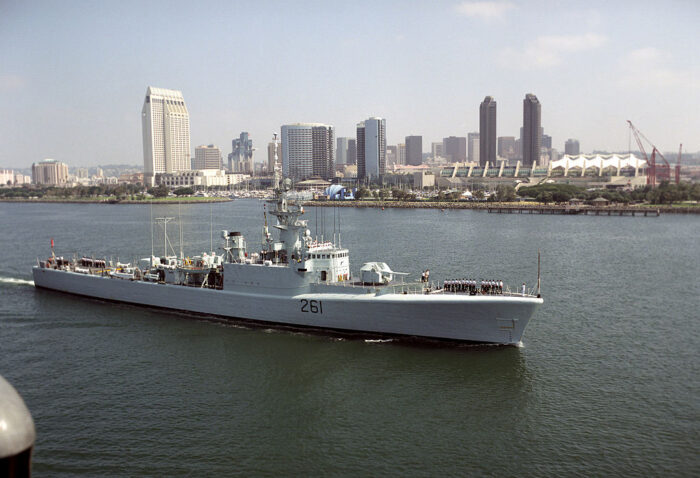
In July 1982, she shadowed the Soviet spy ship Aavril Sarychev in Canadian waters. The latter itself was looking at new American submarines completed at the Washington yard. She had her DELEX refit from 25 May 1986 to 16 January 1987 but was paid off on 3 August 1993. After being scuttled on 16 September 1995 near Isle-de-Lis and Gooch Island (Georgia Strait off Sidney) she became a popular diver’s site, but it’s a dangerous one due to strong currents and everage visibility of 25 feet (7.6 m). Her bell was saved and is now on display at CFB Esquimalt Naval & Military Museum. She was also affiliated with the reserve Seaforth Highlanders of Canada.
 HMCS Saskatchewan DDE 262 (1961)
HMCS Saskatchewan DDE 262 (1961)
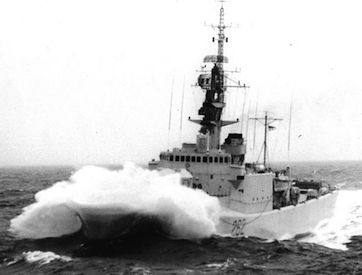
HMCS Saskatchewan was laid down at Victoria Machinery Depot Ltd. in Victoria, British Columbia on 29 October 1959, launched on 1 February 1961 and completed on 16 February 1963. Her initial 31 January launch was pushed by poor weather. In September 1961 she was moved for fitting out to Yarrows Shipyard at Esquimalt. She was deployed to the east coast and patrolled out of Halifax. In April 1963, while underway to the Pacific she was rerouted to Haiti to monitor an insurrection against president François Duvalier, each nation looking after the safety of its own citizens here.. In October 1963 she arrived in the Pacific and on 8 September 1968, she ran aground in the Gulf of Georgia. The captain was later suspended for negligence by a court-martial. She was sent back to the east coast in February 1970 to relieved HMCS Nipigon as flagship of STANAVFORLANT.
In 1973, she was back to the west coast until the end of her career where she served largely as a training ship. In July 1982 she shadowed the Soviet spy ship Aavril Sarychev monitoring the US west coast and Yards. She had her DELEX refit at the Burrard Yarrow, Esquimalt, from 27 May 1985 to 17 June 1986. By late 1986, she sailed to Australia for the Canadian presence during the 75th anniversary celebrations of the Royal Australian Navy. She was vesred in the Training Group Pacific until paid off by on 1 April 1994. Like her sister she was purchased by the Artificial Reef Society of British Columbia in 1997, scuttled off Nanaimo, 14 June 1997.
 HMCS Yukon DDE 263 (1961)
HMCS Yukon DDE 263 (1961)
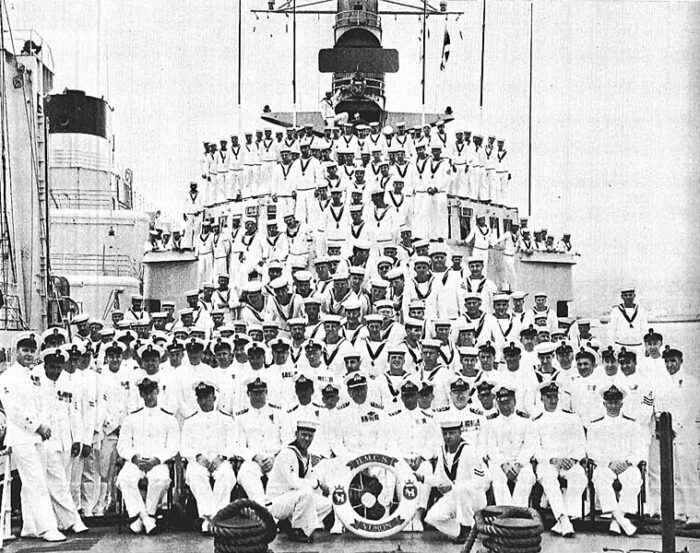
HMCS Yukon was laid down at Burrard Dry Dock Ltd. in North Vancouver (British Columbia) on 25 October 1959 and launched on 27 July 1961, completed on 25 May 1963. She was transferred to the east coast and sailed to Halifax on 27 July, remainining until 1964 with the First Canadian Escort Squadron escorted Queen Elizabeth II on HMY Britannia during her Canadian tour. She resuled her patorlling and training reolmed from 1965. In 1970 she sailed with HMCS Mackenzie and HMCS Provider for a Pacific long range deployment with exercises with several navies and stopping to Japan. In February 1975 she had her mid-life refit and then joined the Training Group Pacific. On 17 January 1983, she collided with USS Kitty Hawk, having her mast slightly damageed. Like her sisters, she underwent her DELEX refit at Burrard Yarrow from 28 May 1984 to 16 January 1985. In 1986, she took part in the Royal Australian Navy’s 75th anniversary celebrations and was decommissioned on 3 December 1993.
Although she was initially purchased by the Artificial Reef Society of British Columbia, she was left at New Westminster docks until purchased for $250,000 by the San Diego Oceans Foundation which towed her to California in 2000, gutted, cleaned, and scuttled under 100 feet (30 m) at Sunken Harbor, Mission Bay (San Diego) on 15 July 2000 but she apparetnetly sank with the SEAL explosive charge on board a day before and divers had to retrieve and disarm these later. Her laying made recreational diving more challenging five died in 2012. Since here the site is serverely discouraged.
 HMCS Qu’Appelle DDE 264 (1962)
HMCS Qu’Appelle DDE 264 (1962)
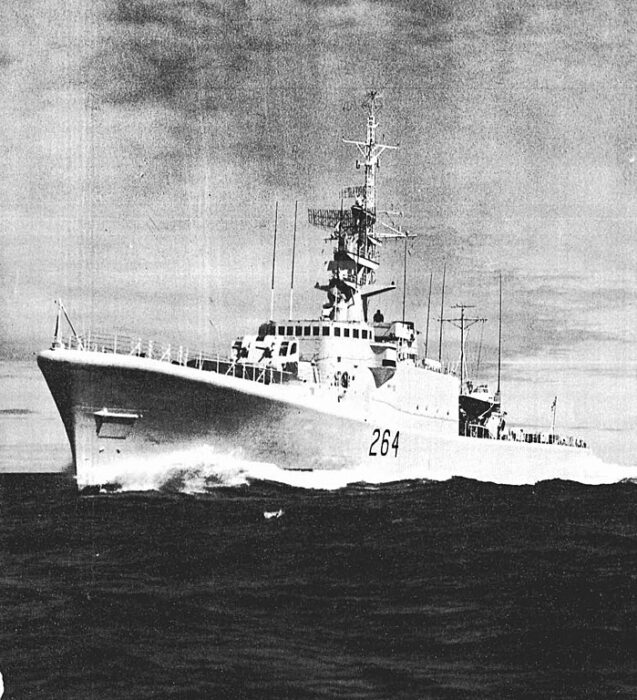
Qu’Appelle was built at Davie Shipbuilding Ltd. in Lauzon, Quebec (hence her name) on 14 January 1960, launched on 2 May 1962 and completed on 14 September 1963. Assigned to the Pacific Fleet in 1964 like her sisters she alternatied betwen patrols and training in local waters, later under the “Maritime Forces Pacific”. In 1971 she shadowed a 7 ships Soviet Pacific task force long the Aleutian Islands, assisted by the replenishment ship HMCS Provider and submarine HMCS Rainbow. On 28 August 1972 she departed with Provider and Gatineau on a four-month training cruise in the Pacific, including Australia, NZ, Japan Guam and Pearl Harbor.
She had her DELEX refit from 25 May 1983 to 13 January 1984 at Burrard, CFB Esquimalt. In 1986, she took part in the Royal Australian Navy’s 75th anniversary. She ended her career as the Training Group Pacific until decommission, paid off on 31 July 1992. She was sold to a Chinese company for BU in 1994. Her bell is on display at CFB Esquimalt Museum and one 3-inch/50 gun at the Canadian War Museum in Ottawa.
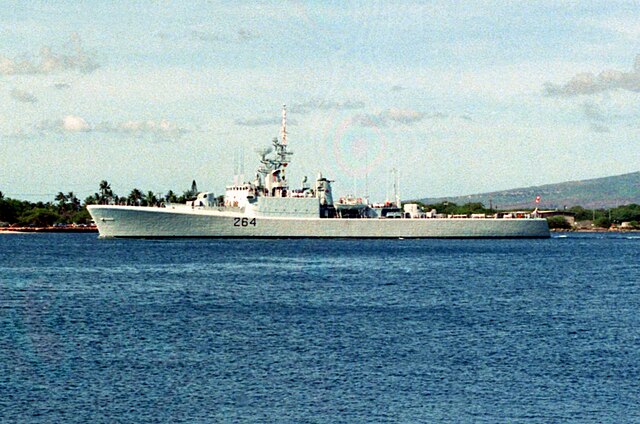

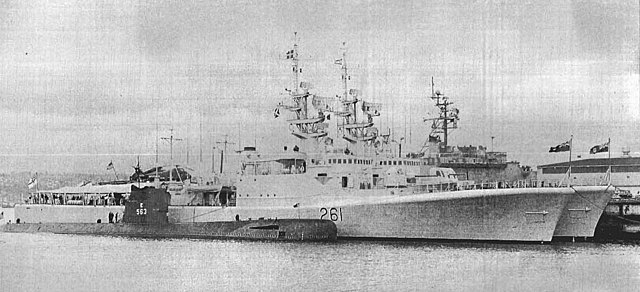
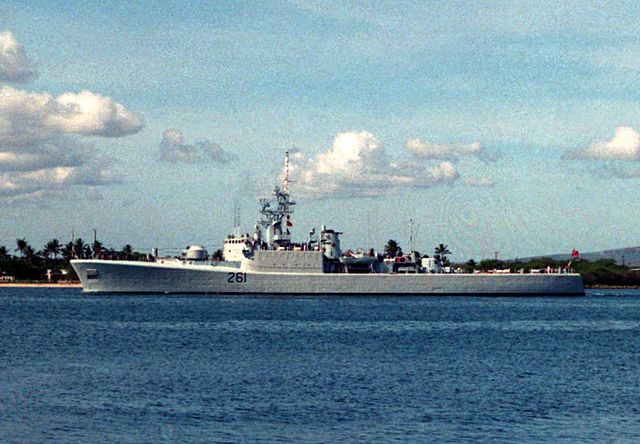
Read More/Src
Books
Barrie, Ron; Macpherson, Ken (1996). Cadillac of Destroyers: HMCS St. Laurent and Her Successors. St. Catharines, Ontario: Vanwell Publishing.
Blackman, Raymond V.B., ed. (1963). Jane’s Fighting Ships 1963–64. London: Sampson Low, Marston & Co.
Boutiller, James A., ed. (1982). RCN in Retrospect, 1910–1968. Vancouver: University of British Columbia Press.
Couhat, Jean Labayle (1978). Combat Fleets of the World 1978–79. Arms and Armour Press.
Friedman, Norman (1986). The Postwar Naval Revolution. Naval Institute Press.
Gardiner, Robert; Chumbley, Stephen; Budzbon, Przemysław, eds. (1995). Conway’s All the World’s Fighting Ships 1947–1995.
German, Tony (1990). The Sea is at our Gates: The History of the Canadian Navy. Toronto: McClelland & Stewart.
Hadley, Michael L.; Huebert, Rob; Crickard, Fred W., eds. (1992). A Nation’s Navy: In Quest of Canadian Naval Identity. McGill-Queen’s University Press.
Macpherson, Ken; Barrie, Ron (2002). The Ships of Canada’s Naval Forces 1910–2002 (Third ed.). St. Catharines, Ontario: Vanwell Publishing.
Milner, Marc (2010). Canada’s Navy: The First Century (Second ed.). Toronto: University of Toronto Press.
Barrie, Ron and Macpherson, Ken. (1996). Cadillac of Destroyers: HMCS ST. LAURENT and Her Successors. Vanwell Publishing Ltd. St. Catherines, Ont.
Steed, Roger G. (1999). Canadian Warships Since 1956. Vanwell Publishing Ltd. St. Catherines, ON.
Jane’s Fighting Ships, Various Editions
Conway’s All The World’s Fighting Ships, Various Editions
Mike Potter’s ST. LAURENT class destroyer tables.
Links
https://www.navypedia.org/ships/canada/can_es_mackenzie.htm
http://www.hazegray.org/navhist/canada/postwar/mackenzi/
https://www.seaforces.org/marint/Canadian-Navy/Destroyer/Mackenzie-class.htm
https://www.silverhawkauthor.com/post/royal-canadian-navy-destroyers-st-laurent-restigouche-mackenzie-and-annapolis-class-1950-1989
https://en.wikipedia.org/wiki/Mackenzie-class_destroyer
Model Kits
None

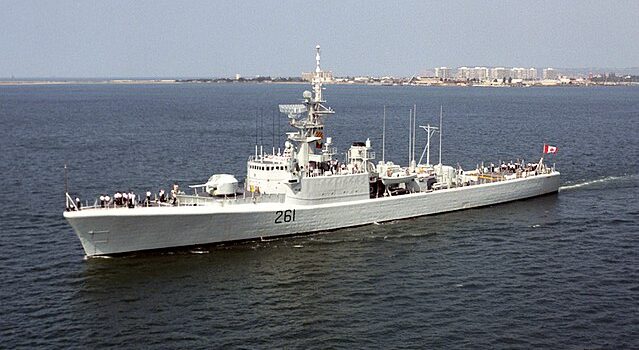
 Latest Facebook Entry -
Latest Facebook Entry -  X(Tweeter) Naval Encyclopedia's deck archive
X(Tweeter) Naval Encyclopedia's deck archive Instagram (@navalencyc)
Instagram (@navalencyc)





 French Navy
French Navy Royal Navy
Royal Navy Russian Navy
Russian Navy Armada Espanola
Armada Espanola Austrian Navy
Austrian Navy K.u.K. Kriegsmarine
K.u.K. Kriegsmarine Dansk Marine
Dansk Marine Nautiko Hellenon
Nautiko Hellenon Koninklije Marine 1870
Koninklije Marine 1870 Marinha do Brasil
Marinha do Brasil Osmanlı Donanması
Osmanlı Donanması Marina Do Peru
Marina Do Peru Marinha do Portugal
Marinha do Portugal Regia Marina 1870
Regia Marina 1870 Nihhon Kaigun 1870
Nihhon Kaigun 1870 Preußische Marine 1870
Preußische Marine 1870 Russkiy Flot 1870
Russkiy Flot 1870 Svenska marinen
Svenska marinen Søværnet
Søværnet Union Navy
Union Navy Confederate Navy
Confederate Navy Armada de Argentina
Armada de Argentina Imperial Chinese Navy
Imperial Chinese Navy Marinha do Portugal
Marinha do Portugal Mexico
Mexico Kaiserliche Marine
Kaiserliche Marine 1898 US Navy
1898 US Navy Sovietskiy Flot
Sovietskiy Flot Royal Canadian Navy
Royal Canadian Navy Royal Australian Navy
Royal Australian Navy RNZN Fleet
RNZN Fleet Chinese Navy 1937
Chinese Navy 1937 Kriegsmarine
Kriegsmarine Chilean Navy
Chilean Navy Danish Navy
Danish Navy Finnish Navy
Finnish Navy Hellenic Navy
Hellenic Navy Polish Navy
Polish Navy Romanian Navy
Romanian Navy Turkish Navy
Turkish Navy Royal Yugoslav Navy
Royal Yugoslav Navy Royal Thai Navy
Royal Thai Navy Minor Navies
Minor Navies Albania
Albania Austria
Austria Belgium
Belgium Columbia
Columbia Costa Rica
Costa Rica Cuba
Cuba Czechoslovakia
Czechoslovakia Dominican Republic
Dominican Republic Haiti
Haiti Hungary
Hungary Honduras
Honduras Estonia
Estonia Iceland
Iceland Eire
Eire Equador
Equador Iran
Iran Iraq
Iraq Latvia
Latvia Liberia
Liberia Lithuania
Lithuania Mandchukuo
Mandchukuo Morocco
Morocco Nicaragua
Nicaragua Persia
Persia San Salvador
San Salvador Sarawak
Sarawak Uruguay
Uruguay Venezuela
Venezuela Zanzibar
Zanzibar Warsaw Pact Navies
Warsaw Pact Navies Bulgaria
Bulgaria Hungary
Hungary

 Bundesmarine
Bundesmarine Dutch Navy
Dutch Navy Hellenic Navy
Hellenic Navy Marina Militare
Marina Militare Yugoslav Navy
Yugoslav Navy Chinese Navy
Chinese Navy Indian Navy
Indian Navy Indonesian Navy
Indonesian Navy JMSDF
JMSDF North Korean Navy
North Korean Navy Pakistani Navy
Pakistani Navy Philippines Navy
Philippines Navy ROKN
ROKN Rep. of Singapore Navy
Rep. of Singapore Navy Taiwanese Navy
Taiwanese Navy IDF Navy
IDF Navy Saudi Navy
Saudi Navy Royal New Zealand Navy
Royal New Zealand Navy Egyptian Navy
Egyptian Navy South African Navy
South African Navy






























 Ukrainian Navy
Ukrainian Navy dbodesign
dbodesign